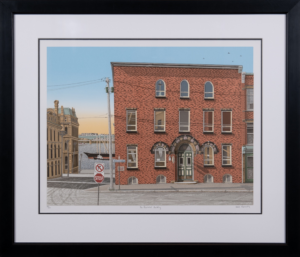Herzl Kashetsky
The Provincial Building

Born in Saint John, New Brunswick in 1950 her grandfather emigrated from Lithuania about 1900, B.F.A., Concordia University, Montréal, Québec (1977)
Herzl Kashetsky’s work in the early 1980s tended to reflect subjects common to the magic realist school, especially still life, focusing on every day objects with an intensity that inevitably invests them with new and deeper meaning. Initially belonging to a regional art movement centred in Atlantic Canada, the magic realists combine almost photo-realist painting with a surrealist use of light and objects to create images that superficially reflect reality, while commenting on the nature of that reality through an unusual intensity of mood. Kashetsky’s 1992 series, Beach Stones, is an example of some of his most meticulous work, following up on a theme that sprang from an 1989 series, Creation, about the seven days of Creation. In Beach Stones each painting is a loving recreation of a beach stone surface, containing dozens of stones piled together, in which each stone is treated with absolute realism, having its own particular surface and shadow. Also at this time, he was painting family portraits and self-portraits that in some ways became part of his 1996 series, A Prayer for the Dead. Although he had been occasionally painting works on the theme of death since 1974, a visit to Poland and some concentration camp sites in 1990 prompted him to create this series, which he says was his way of paying respect to the dead, to the victims of the Holocaust and also to those he has lost from his own life. He worked from photographs, explaining, “I didn’t live though the Holocaust, so I think it would be a little pretentious of me to interpret the pain and suffering. I felt I should take the facts and present them in a documentary style . . . so that you, yourself, would become a witness to the Holocaust, because you’re only twice removed” (1997). In this series Kashetsky’s style takes on a completely different, haunting tone, in the faces of those dying, a crematorium door, a mass grave, all painfully recreated to the last detail. Mass Grave, Bergen Belsen bears a strange resemblance to the beach stone series, the bodies of the dead being jumbled together just like the stones, yet each one commemorated through the artist’s careful and delicate rendering. Of the series, curator Tom Smart has said: “As I came to know Herzl and his work as an artist, I learned that his lifelong project is to bear witness to the large themes of humanity in deeply meditative works. By seeking to understand the Holocaust, he travelled on a pilgrimage to one of the death camps. His journey was not simply an artistic or experiential quest, but also a spiritual pilgrimage to understand the personal dimensions of tragic events” (1997). Kashetsky is also vice-chairman of the Saint John Advisory Board and art advisor of the Saint John Jewish Historical Museum. He has taught classes at the New Brunswick Community College. In 1992 he received an honorary doctorate from the University of New Brunswick and a commemorative medal for outstanding artistic contribution to the community, for Canada’s 125th anniversary of Confederation. In 1997 he received the New Brunswick Red Cross Humanitarian Award, and a best picture award at the 53rd annual exhibition of the Canadian Society of Painters in Watercolour.